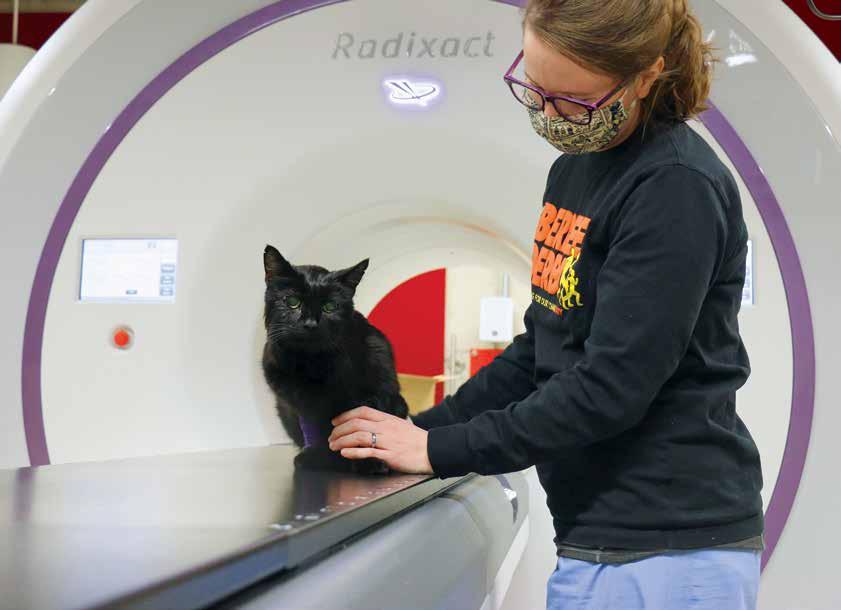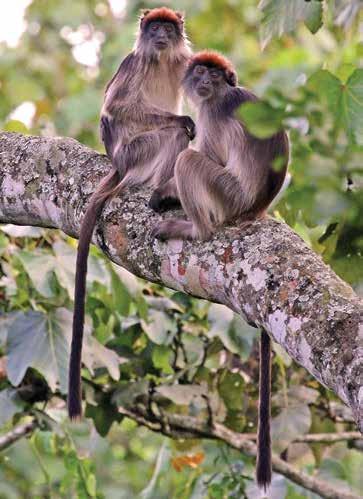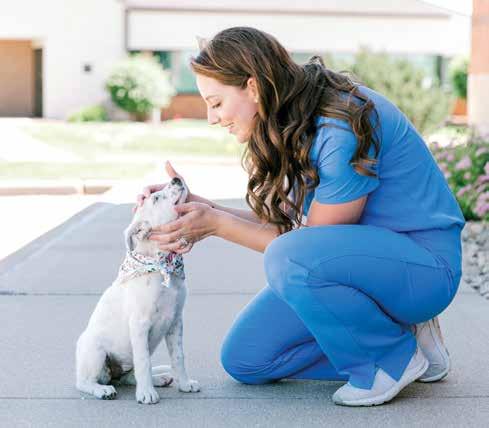
6 minute read
DVM Badger Den

Advertisement
Former resident donor and teaching cows Maxine and Lois enjoy retirement on the farm of Eric Howlett DVM’18 (lower left) and his wife Bethany (top left).

Eric Howlett DVM’18 grew up in the sprawling Texas suburbs of Houston and freely admits to never touching a cow until he visited a UW School of Veterinary Medicine (SVM) open house for incoming students.
“Maxine was my first,” he says fondly, referring to the school’s Holstein teaching cow. Later, during his large animal rotation as a student, he met Lois, the second of the school’s teaching cows. “Those girls spoiled me. They were not intimidating at all,” he recalls.
Lois, named after Lois Lane of Superman fame, and Maxine were treasured among School of Veterinary Medicine students in their role as teaching cows, helping students learn bovine physical examination skills. They also served as a source of whole blood, plasma, and rumen fluid donations for cow patients of UW Veterinary Care.
Lois was six years old when she came to the SVM in 2013, joining Maxine who had been there since she was four. (Lois is currently estimated to be about 13 years old and Maxine approximately 14). Both were aging gals when Howlett, as a fourth-year veterinary medical student, was assigned daily care and feeding of the pair. Standing in their stalls one day, looking gently in on them, he wondered what would come of them in their old age? Later in the semester, Howlett asked Ruthanne Chun DVM’91, the school’s associate dean for clinical affairs and UW Veterinary Care director, “Do they have a retirement plan?” After learning from Chun that nothing had been formally planned for the cows’ retirement, Howlett made an offer. “Well, I have a farm and pasture — they can come live with us,” he recalls telling her.
Howlett, who came to the Doctor of Veterinary Medicine program after completing a PhD and working in research, had recently moved to a hobby farm outside of Madison with his wife Bethany. “The place was a dairy farm in the 50s,” he says. “The most recent owners had it set up for cow, calf, and goat operations. It was perfect. All we needed to do was add animals.”
In July 2019, after a party at the school bidding the cows farewell, a trailer pulled up to Howlett’s driveway. With this special delivery, Maxine and Lois’s retirement officially began. (A new pair of teaching cows, Ginger and Daisy, have since joined the school.)
“Every day Maxine and Lois get a bale of hay in the a.m. and another bale at night. Plus, a scoop of grain when I get home from work. Maxine bellows if I forget. Oh, and bananas too. I buy the brown ones at the store just for them,” laughs Howlett, now a veterinarian at the Mazomanie Animal Hospital not far from his farm.
The pair enjoy a free-roaming life, having access to the entire property. They divide their time between pastures, driveways, barns, and drinks at the pond. Even though the property is fenced, Maxine is an escape artist — finding every gap in the fence. Luckily Lois tattles on her with a long, strong bellow. When Eric or Bethany hear bellowing, they know Maxine has broken out again. But most often, the pair is seen wandering the woody hillsides. “The old girls love to wander up there and settle in — watching over the farm. A habit they must have perfected after spending years in the vet school stalls, watching the busy students go by,” he says.
One unique detail about having former donor and teaching cows is that both of the animals still have a porthole, called a fistula, in their side. While at the hospital, this covered opening allowed for access to the cows’ stomach to retrieve rumen fluid donations, which helped reestablish the gut microbiome of ailing patients. (Throughout their tenure, Maxine and Lois donated to hospital patients a combined 1,400 gallons of ruminant fluid and 1,200 liters of blood.) Under Howlett’s care, he is making good use of the fistulas — now to deliver pain medication. “As older cows, they get arthritic, just like we do. I give them meloxicam for pain. Their fistula ports work well for this. I pour the medicine right into their stomach,” he says.
It’s been nearly two years since their arrival and everyone seems to have settled into a bucolic routine. Lois and Maxine share their pen with a herd of goats. When the temperatures dip, they all snuggle up together. Other members of the crew include Abe, a Great Pyrenees mix, and Lupini, a Catahoula Leopard Dog-heeler mix, along with flocks of chickens, guineafowls, and a few barnyard cats.
“When I go out to the pasture with a beer or coffee in hand, I count on Maxine wanting to drink it,” Howlett says with a smile. “It’s all those little things that add up … our golden girls living their best lives. I’m just happy to see them so happy.”
Denise Garlow
In Memoriam
The UW School of Veterinary Medicine regrets to announce the loss of an alumnus.
Joseph Edward Kelley DVM’89, 59, passed away in November following a four-year battle with amyotrophic lateral sclerosis (ALS). “Joe was the person who made everybody feel like a somebody,” his obituary reads. Veterinary medicine was Kelley’s passion. He served as a clinician, surgeon, mentor, and teacher to many at Sauk Prairie Small Animal Hospital. He also went on seven international relief trips offering free spay and neuter clinics. Through these trips, he impacted many young veterinarians and built connections with all he met.
A Message to DVM Alumni
Looking Forward
As I write this, we still have plenty of snow on the ground, which I hope will no longer be the case when you read this. (I do love the snow — I am just especially ready for spring this year!) And it occurs to me that while I believe in living in the moment, looking forward is really important right now. I am grateful for so many good things to be excited about in the year ahead.
Of course, the COVID-19 vaccine is top of that list, as I am eager for us all to begin returning to something a lot closer to the normal we knew before the pandemic. I would be remiss if I did not highlight veterinary medical professionals’ critical role in the pandemic response, from serving on the public health frontline and aiding diagnostics, to advancing SARS-CoV-2 research and vaccine development, to providing essential animal care that has only increased in demand over the past year. Thank you!
I am also looking forward to breaking ground on the long-awaited (and much needed) building expansion project. So many of our alumni and other friends have helped get us to this point. This expansion will significantly enhance our ability to provide exceptional patient care, outstanding teaching and learning opportunities, and critical research advancements that benefit animal and human health. We are thrilled and grateful to move ahead.
These are just a few highlights. I can’t wait to see more people in person (including, I hope, at alumni events this year), to be back in the SVM building with fantastic colleagues and inspiring students, and the list goes on. If I learned nothing else this past year, it’s that I really can’t predict what lies ahead. But I still feel pretty confident in knowing that good things await us in 2021.
Take care and be well.
Kristi V. Thorson
Associate Dean for Advancement and Administration






